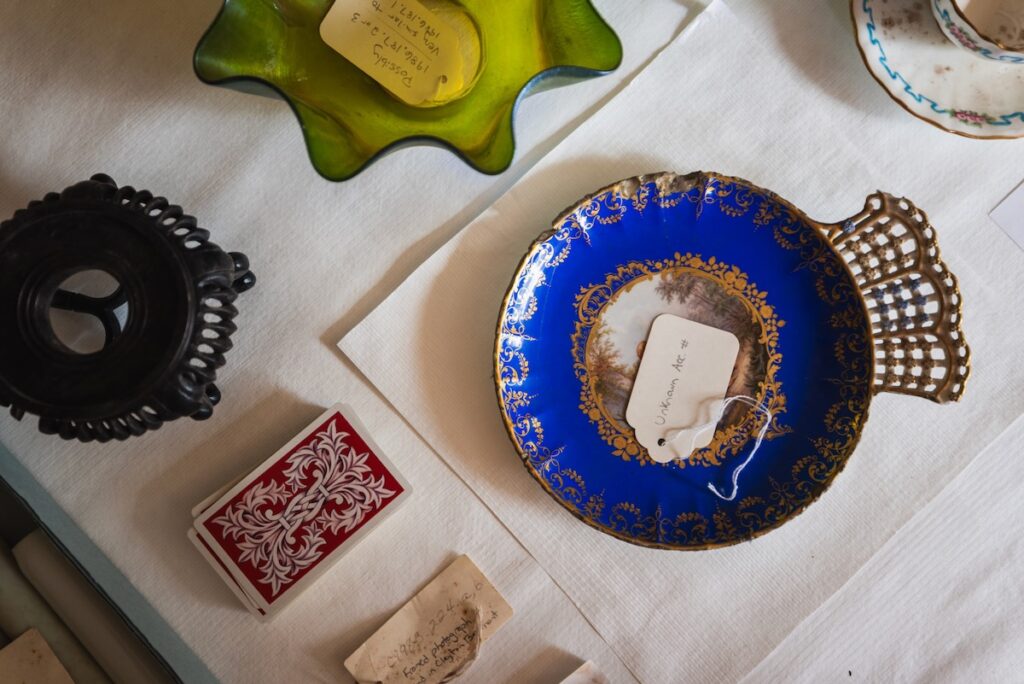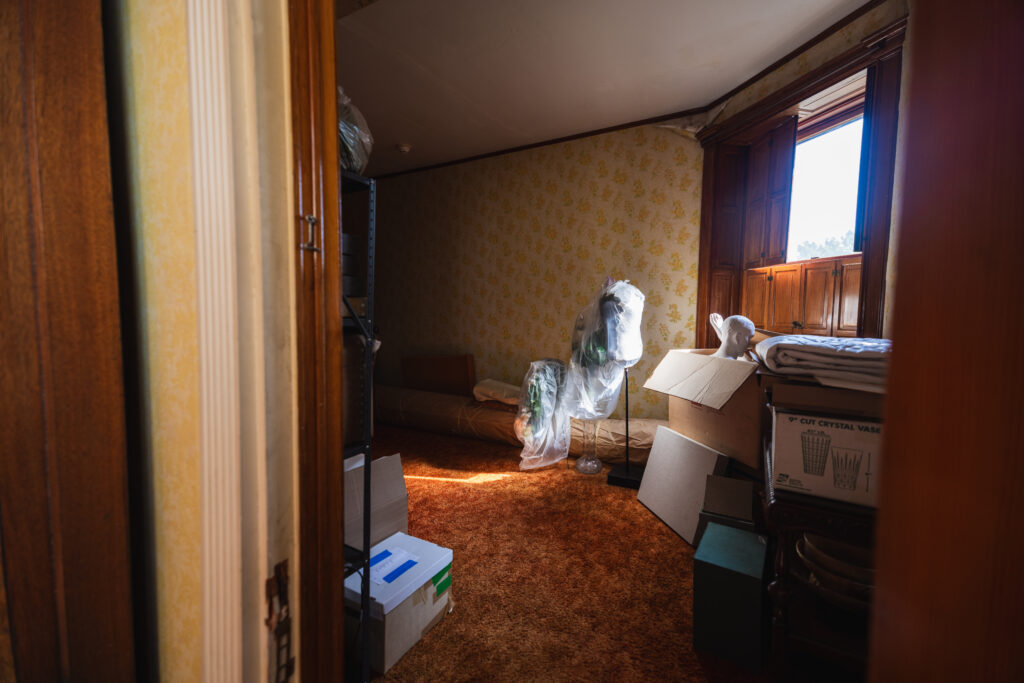A guide pulls a rope from its hook and leads you up red velvet stairs into the unknown. This isn’t a speakeasy or a hot new club—it’s the upper floors of Henry Clay Frick’s estate, Clayton, on the grounds of The Frick Pittsburgh. The third and fourth floors of Clayton have never been seen by the public before, and as of fall 2025, visitors can be among the first to see these parts of the Frick family residence. Rather than the curation of the lower floors, which freezes Clayton in time to educate visitors about its history, the upstairs floors show the home as a living, dynamic archive.
As you walk into the rooms on the third floor, you’ll find a plethora of broken plates and “mystery objects” marked with accession numbers. It’s a delight for any lover of tchotchkes and trinkets, with playing cards, candle sticks, Polaroids of objects throughout the home, and a mother-of-pearl inlaid card game score counter. “Part of the fun of this tour is getting to see how these rooms are used in the present day,” Collections and Exhibitions Assistant Bella Hanley explained.
It’s an unconventional choice to allow visitors behind the curtain, so to speak, and into the museum staff’s workspace. Viewing the upstairs floors also allows visitors to see that Clayton was occupied—and renovated—well into the ‘70s and ‘80s. The sewing room or caretakers’ room has fluorescent orange walls and ‘70s shag carpet. A mannequin’s white plastic foot sticks out of a cardboard box, and one corner is entire full of bright scarlet pointsettias. Hanley noted that not even tour guides got to go upstairs until recently.
The Frick Opens Up Never-Before Seen Floors of Clayton
The upstairs tour continues Gilded, Not Golden’s theme of highlighting not just the Frick family but their staff, through the chauffeur’s room and the governess’s room. But it also provides an even more intimate look into Frick family life. One of the most frequently-asked questions on the Gilded, Not Golden tour is where Childs Frick’s room was. The answer is the third floor, where you can see images of Childs’ room decked out with guns, swords, and Princeton University merch. Just a typical Gilded Age man, obviously. But what remains is now its high ceilings, stained with water damage, and wide bay windows. “We’re constantly fighting against the elements,” Hanley said. “We look at structural problems one step at a time.”

Seth Culp-Ressler/The Frick Pittsburgh
Another Side of Helen Clay Frick’s Vision
One might wonder, to put it in the crudest terms, what can be gained by seeing a bunch of boxes and water-damaged ceilings. But it lays bare the fact that just as the tour highlights the laborers in the Frick family, contemporary laborers are behind the preservation of the objects and the museum experience as a whole. Museums don’t simply appear out of thin air and an archive as rich as the Frick’s requires constant stewardship.
Seeing more parts of Clayton allows you to see Helen’s Clay Frick’s life evolve as the daughter of the home to its curator. By the time she passed, Helen had four homes she’d inherited from her family, and trainloads of items arrived in Pittsburgh for the conservators of Clayton. Helen remained unmarried her whole life, and her love for her family homes made me wonder if real estate functioned as something for her to care for and nurture in lieu of a traditional marriage. Upstairs, we see Helen’s handwriting on one of her father’s suitcases, simple curlicues that read “papa.”
A striking moment in the tour is seeing a panel in the chartreuse walls of Helen’s schoolroom that opens to dark wooden beams. It felt like a metaphor for the Gilded Age itself, a shiny exterior with darkness underneath. But it also represented, to me, that looking closely at historical spaces like Clayton reveals so much more than meets the eye. There’s always more to learn, even behind the prettiest of walls.
The Frick in Constant Evolution
The opening of the upstairs is just one of the ways the Frick’s team has taken what could easily be a stodgy, stuck-in-the-past site and committed to evolving it. Some of that is their top-notch community engagement and consistent listening to visitor feedback. “People said ‘I’d pay anything to see what’s up there,’” Hanley said. “So, we decided to test that out.” The upcoming tours, which open in November, will have 16 slots a week available to view the upper floors.

Seth Culp-Ressler/The Frick Pittsburgh
I feel now, after visiting Clayton multiple times and seeing a wide range of exhibitions at the Frick, a deeper connection to Helen. While her brother dug up dinosaur bones and started his own family, Helen was at her father’s right hand, a woman of shrewd intelligence at a time a woman’s intelligence wasn’t likely to get her as far as a man’s. Her views on art and society at large leaned more conservatively, and by Hanley’s own admission “a lot of what we do today would have Helen rolling in her grave.” But she wanted people to get to see her family home and enjoy it, even if it’s accompanied by a museum showing modern art that wasn’t to her taste. By both honoring Helen’s memory and transcending her vision, the Frick moves its programming into the future.
Story by Emma Riva
Photo Courtesy of The Frick Pittsburgh
